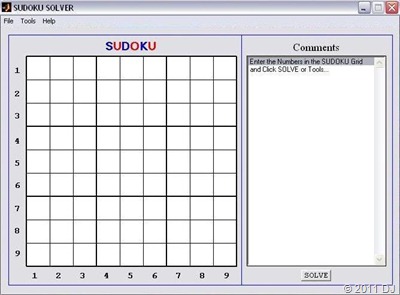In this post, I’m going to rant about
SUDOKU SOLVER
, its origin, appearance and functionalities. The idea for SS originated in my head after Shantanu tried to teach me (well, I did ask him!) how to solve a Sudoku. It was during one of the CMP Lab hours of Autumn’05 before Puja holidays. He taught me a ‘human’ variant of the logic ‘Deduction & Reduction’ apart from looking for ‘Single Possibilities’ as described later.
It seemed to me that these ‘Logics’ could be coded and a logical Sudoku Solver made, which would mimic how ‘I’ would solve one! I thought about this quite a lot over the holidays and even came up with two more Logics ‘Deduction from doublets’ & ‘Reduction to doublets’. Later, these were generalized to ‘Deduction from Multi-sets’ & ‘Reduction to Multi-sets’. Two more logics ‘Deduction from Num-Grids’ & ‘Deduction from Num-Chains’ were added subsequently. Each Logic is assigned a number (like 3 for SP) which are summed, depending on ‘how much’ Logic goes into solving, to give a Sudoku its numerical score and assign one of the ten difficulty levels: ‘Easiest’, ‘V. Easy’, ’Easy’, ‘Below Average’, ‘Average’, ‘Above Average’, ‘Hard’, ‘V. Hard’, ‘Hardest’ & ‘Out of the World’.
I decided that the major version number should reflect the number of Logics coded and the minor version should reflect… my Whim! The GUI for SS has remained the same since its inception. Though, the three menus (‘File’, ‘Tools’ & ‘Help’) have gained a few additions over time. Have a look at the oldest & the newest GUI:

You can obviously Solve a Sudoku Completely but even Partially, which basically displays all the possibilities of individual (≤ 81) cells! However, there is no option of interrupting the (complete) solver and demanding the ‘partial’ results. (It is a Solver not a Trainer!) At first, I thought of not adding a Brute Force Algorithm but the graphics aspect of updating numbers while the recursive algorithm ran led me to include it! I also included an option ‘Use Logic’ but it can not be unchecked by usual means! The most latest addition is Speech Recognition, which allows one to input numbers by speaking them out loud as seen in this video:
SS features a silly ‘security’ feature which supposedly prevents one from running the executable file of one computer on another! SS also asks for your name on the very first start to ‘license’ the program to you, which is displayed in ‘About SS’. It also saves the last Sudoku you solved for easy retrieval apart from providing usual functions like ‘Import’ & ‘Save’. You can also ‘Print’ the current screen to a .jpg file or a MATLAB figure. A Help file (accessible via ‘SS Know-How’) is included with the program along with a link to this post via ‘Learn SS Logic’. The latest release also has ‘Update’ & ‘Uninstall’ options!
This blog post will take place of the earlier Logic.pdf file as I link to the Site, which has an extensive collection of Logics used in Solving a Sudoku. The names (& possibly the implementation) of the ‘Strategies’ on that site differ from the names of the Logics in my Solver! In what follows, I’ll point out the many-to-one correspondence of the Strategies (30 excluding the Uniqueness & Trial and Error strategies) and Logics (6) below in [square brackets].
v1.0; Release 0 (2005) Single Possibilities [1, 2]
The simplest logic: Fill-in the single possibility for the particular cell! It can be represented in 4 ways:
Cell(R,C):N => Only no. (Abs. [Row, Col., Squ.])
R stands for Row (vertical numbers), C stands for Column (horizontal numbers) & N stands for the number filled in the specified cell.
v2.0; Release 0 (2005) Deduction & Reduction [6, 7]
Again 4 representations are possible here:
Squ.[sR,sC] & Row [Col.] R [C]: N =>
N removed from Row [Col.] R [C]
Row [Col.] R [C] & Squ.[sR,sC]: N =>
N removed from Squ.[sR,sC]
v3.0; Release 1 (2005) Reduction to Multi-sets [4]
3 representations are possible corresponding to 2, 3 or 4-sets. Sample shown for a 2-sets (doublet):
Cell(R₁,C₁) Cell(R₂,C₂): D₁ D₂ =>
N₁[N₂…] removed from Cell(R₁,C₁)
[M₁… removed from Cell(R₂,C₂)]
v4.x(0≤x≤9); Release 2-4 (2005-06) Deduction from Multi-sets [3, 5]
9 representations are possible ([2,3,4-sets]x[R,C,S]) here. A sample for doublet x R looks like:
Cell(R,C₁) Cell(R,C₂): D₁ D₂ =>
D₁ removed from Row R
[D₂ removed from Row R]
v5.x(0≤x≤5); Release 5-9 (2006-09) Deduction from Num-Grids [8, 11, 15]
6 representations are possible ([2,3,4-grids]x[R,C]) here. A sample for 2-grids x C looks like:
Cols(C₁,C₂) & Rows(R₁,R₂): G =>
G removed from Col.C₁ & Row(s):R₃[R₄…]
[G removed from Col.C₂ & Row(s):R₃…]
v6.x(2≤x≤7); Release 10-15 (2009-∞) Deduction from Num-Chains [9, 14]
4 representations are possible here:
NC – Type Ia:
N in Cells:(,) (,) […] &
N removed from Cells:(,) (,) […]
NC – Type Ib:
N in Cells:(,) (,) […] &
(,) […] =>
N removed from Cell(s):(,) […]
NC – Type IIa:
N in Cells:(,) (,) […] &
(,) […] with
N in Cell(s):(,) […] &
N removed from Cell(s):(,) […]
NC – Type IIb:
N in Cells:(,) (,) […] &
(,) […] with
N in Cells:(,) […] &
(,) […] =>
N removed from Cell(s):(,) […]
That makes a total of 12 out of 30 Strategies in SS, not bad, not bad at all! I’ve wanted to implement Y-Wing [10] & its generalizations [13, 18], which overlap with APE [19] for a long time but I guess that won’t happen in the near future. Anyway, I end this rather long post with


No comments:
Post a Comment